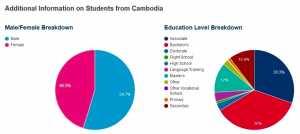Breaking into Cambodia: Asia’s new tiger economy
“Cambodia, which was once a country synonymous with conflict and poverty, now has one of the fastest growing economies in Asia”
An economic transformation, demographic change and greater access to digital resources are all driving demand for study abroad among Cambodian students. Mark Ashwill, managing director of Capstone Vietnam, shares why the market is ripe for overseas institutions looking to recruit international students, and what they should consider when they do.
Cambodia, which was once a country synonymous with conflict and poverty, now has one of the fastest growing economies in Asia. The country’s gross domestic product has grown by 7% or more each year since 2011 and is expected to maintain that pace through 2017, according to Asian Development Outlook 2016, produced by the Asian Development Bank.
The country has embraced the “factory Asia” model of economic growth, deploying low-cost labor to manufacture products for export. As the price of labor increased in the People’s Republic of China and other Asian countries, Cambodia was able to attract many of these investors, especially in the production of garments and footwear for export.
In fact, the World Bank reclassified Cambodia’s economy from “low-income” to “lower-middle-income” last year. This simply means that its GNI per capita income (PCI) has exceeded $1,026, which doesn’t mean a lot for most Cambodians, given the aggregate nature of PCI. (The lower-middle-income range tops out at $4,035.)
The challenge for Cambodia – in which the gap between rich and poor, rural and urban, is huge – is to diversify its economy towards higher value-added products and services. Garments and footwear comprise 70% of total exports, which is an example of putting too many economic eggs in one basket. Chances are good that some of your clothing was “made in Cambodia” or Vietnam.
“Cambodia has a demographic dividend that is must take advantage of through higher quality education and training”
Still, the country has made phenomenal progress considering its very bleak starting point: the death and near-total destruction wrought by the Khmer Rouge from 1975-79. Cambodia now has a population of nearly 16 million and a median age of about 25. The fact that its population is so young means it has a demographic dividend that is must take advantage of through higher quality education and training.
Growing demand for overseas study
Rapid economic growth has created a small yet growing demand for private domestic education and overseas study, mainly at the higher education level. According to data published last year by the UNESCO Institute for Statistics that are already several years old, 4,221 Cambodian university-level students are studying outside the country.
The top 10 destination countries for Cambodian students are Thailand, with 955 students, and Australia, with 602. Vietnam follows, then France, the US, Saudi Arabia, Japan , South Korea, New Zealand and the UK.
As of March, based on the latest SEVIS update, there are 702 young Cambodians studying in the US (compared with 1,594 from Myanmar and 30,817 from Vietnam). There is at least one Cambodian student in every state except Alaska, Delaware, Nebraska, West Virginia, and Wyoming. Not surprisingly, CA hosts nearly a third of all Cambodian students, and the top five states – including MA, WA, TX and NY – account for nearly 60% of the total. If your institution is not located in one of those states, your work will be more challenging, but not impossible.
As you can see in the SEVIS chart below, about two thirds of Cambodian students in the US are enrolled in a higher education institution: 30.3% studying at a community college and 36% at a four-year school.

Internet surpasses traditional media as main source of news
All but 4% of Cambodians now own a phone and that 48% own a smartphone, a 21% increase from 2015, according to The Asia Foundation’s 2016 annual survey of mobile phones and internet usage. 37% of respondents said they use or have used the Internet, and 33% said they accessed the internet using their own phone. 48% said they have used Facebook while 37% of Cambodians indicated that they used Facebook on their own phone. Facebook is now the number one news source in Cambodia, having surpassed television.
One positive trend that has allowed more people to access the Internet is large-scale consolidation of the telecoms, which has lowered prices and increased revenue with more data use, according to Asia Foundation country director, Silas Everett. This is good news not only for the e-commerce industry but also for foreign educational institutions that wish to brand and promote their institutions and related activities in Cambodia through digital marketing.
NOTE: Cambodia now has a 4G network and wi-fi access is ubiquitous.
Prospects for US institutions of higher education
There are some US colleges and universities that are recruiting in Cambodia, though the number is still relatively small at this point. Here are some tips and initial questions for colleagues who are considering adding Cambodia to their list of priority countries.
- Consider your cost and location. What are your school’s main “selling points” in Cambodia?
- What is your recruitment strategy? Are you willing to invest the time and money that will ensure a long-term commitment to this new yet expanding and promising market?
- Do you have a budget for digital marketing?
- Are you willing to consider the possibility of in country representation, at least on a part-time basis?
Leave a Reply